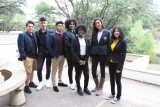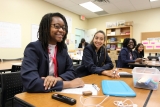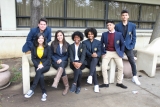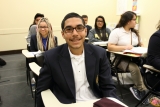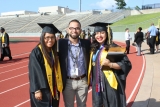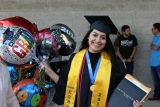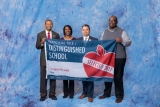-
Category 1
Selected in 2017
-
Grades: 9 - 12
School Setting: urban
Town Population: 7
Student Enrollment: 432
Student Demographics:
Black/African American: 9.2%
Teacher/Student Ratio: 1:25
White/Caucasian: 1.2%
Hispanic: 88.2%
Hawaiian/Pacific Islander: 0.7%
Asian: 0.7%
Native American: 0%
Other: 0%
% Reduced Lunch: 85.8%
% ELL Learners: 5%
Founded: 2006 -
PRINCIPAL:
Macario Hernandez -
CONTACT:
4849 W. Illinois Avenue
Dallas, TX 75211
214-860-3680
jgreenwood@dallasisd.org
Trinidad Garza Early College High School at Mountain View
Dallas, TX
School transformation happens through being an eager listener, passionate educator and an optimistic leader of your students’ future.
- Describe specific programs in place to ensure that families are involved in the success of your school and students.
- At Garza ECHS, programs and practices to encourage family and community engagement are created based on community and school need. Garza ECHS has initiated Parent Academy and coffee with the principal sessions to empower parents.The Parent Academy workshops, which have an average attendance of 120 parents, have been purposefully and intentionally developed to meet the needs of our parents and students. Parent interest leads to the development of agendas for the Parent Academies. Furthermore, Garza ECHS has a committed Parent-Teacher-Student-Organization and a Site-Based Decision Making Team. Students and parents are involved and provide decision-making advice to leadership in "roundtables". This empowers students and parents to have a genuine voice at our school. Parents are assured that we will continue to provide solutions until any problem is solved – tenacity in finding solutions is a roundtable hallmark. Parents feel comfortable coming to our school because we are solution-oriented and not judgmental.
- Describe the most successful activity your school has initiated to strengthen ties to your community.
- Community has become a hallmark of our campus. One such example is student leadership in blood drives to the Carter Blood Bank. Our school received the Community Gold Award for the high number of pints of blood that have been donated to the community. The blood drive efforts are student-led and demonstrate a commitment back to the community. Some of the best successes have come from partnerships and collaborative efforts with non-profits, local businesses, and colleges. One example is our neighborhood walks with Mountain View College campus member. Other non-profits like LULAC, a non-profit organization with the mission to advance education for Latin@, joins us as we walk the surrounding community to build relationships with our stakeholders and promote both our high school and college.These partnerships equal success for the student. We intentionally develops programs and practices to engage all stakeholders from the community. This is how we define collaborative partnerships!
- Describe your philosophy of school change or improvement.
- My philosophy of school change and improvement is grounded in a collective, collaborative, and relational leadership approach. Relational leadership is one of relationship building and collaboration with all school community stakeholders. As principal, I organically elicits input and stories from various stakeholders – the community, the teachers, the parents, and the students. The purpose for gathering input from all theses stakeholders is to identify the root cause of any issues that surface. Then, collectively, core groups are established to help resolve the areas of improvement. This is a long extensive, collaborative process. As such, school change cannot happen in isolation or through unilateral decision making. I believe in the philosophy that "it takes a village" to attain authentic school change. School transformation happens through being an eager listener, passionate educator and an optimistic leader of your students’ future. It has been my experience that positive school change effectively occurs through theses shared visions and powers, where the principal empowers all stakeholders to participate in process.
- What are your school’s top two goals for the next year?
-
One of our top goals for next year is to provide more internship opportunities to our students within the Dallas community. By allowing our students to participate in various internships, we can give our students hands-on experience and a window into potential careers.
Our second goal for next year is to alleviate as many financial barriers as possible through the continuation of the Dallas Promise Program. We want to raise awareness to our students about the opportunities they have to finish their associate degree and bachelor degree free of cost. - What is the single most important factor in the success of your school that others could replicate?
- Addressing not only the academic, but the social/emotional needs of the students is key towards the success of our school. The Garza Intervention Team is composed of teachers, counselors, administrators and the nurse.The purpose of this committee that meets on a weekly basis is to address the academic, social, and emotional needs that impede the student(s) from being academically successful.The needs are placed in one of the four categories: Academic, Health, Attendance and Behavior.Students are referred to this committee by faculty and data is the main component that drives the interventions.The interventions range from round table meetings with the student and parent, after-school tutoring, guidance by the counselors, and/or Reading and Math enrichment classes that are embedded within the regular school hours. Through the ongoing academic support we are able to personalize learning and prescribe the necessary individualized interventions to help the child be successful.
- Describe the program or initiative that has had the greatest positive effect on student achievement, including closing achievement or opportunity gaps, if applicable.
-
Academic planning is vital in guiding our students to earn their high school diploma and associate’s degree. This takes a lot of coordination between the college advisor and school counselors. All students meet with the high school counselors to discuss the classes necessary to earn their high school diploma. The school counselors are intentional in offering support by scheduling informational meetings for our parents and offering classroom guidance lessons, small groups, and individual counseling to ensure that students are equipped with the knowledge and skills to navigate through their four years of high school. In addition, our students also meet with the college advisor and create an educational planner of the remaining classes needed to earn their associate’s degree/certificate. Counselors continuously review the students’ educational plan to ensure that they are on track and to identify classes that they might need additional support in.
- Explain how Title I funds are used to support your improvement efforts.
-
Instructional aides
instructional coaches
National best practice conferences
- Identify the critical professional development activities you use to improve teaching and student learning.
- Professional development (PD) plays a vital role in forging Garza ECHS students into exceptional learners. PD begins with an organic “systems” data analysis – formative and summative. Internal coaching, both teacher-led and instructional coach/principal-led, follow and are tied directly to data - what is currently observed in classrooms as well as student assessments. Coaching takes place in faculty meetings, after-school sessions, and classroom peer-coaching/mentoring. Inter-visitations between classrooms are also a “system” of professional development at Garza ECHS. Teachers visit other teachers using a “problem of practice” as the focus. Furthermore, teacher-led professional are driven by students' social emotional needs, student performance and our Campus Action Plan. Teacher-leaders: a) present how to deeply analyze student data to inform instructional practice; b) model student engagement strategies; c) demonstrate how students can effectively use interactive notebooks (interactive notebooks are required in all core subjects); and d) present our campus-wide writing rubric to show faculty how this unifies our literacy initiative.
- Describe how data is used to improve student achievement and inform decision making.
- We are a data-driven school which bases all learning decisions on student data derived from a variety of assessment tools, including college entry exams (TSI), district-developed semester finals, statewide end-of-course exams, national tests including the SAT and ACT, and classroom tests -all of which guide our teachers to make informed decisions to best serve our students. Teachers begin by examining content-specific performance on assessment data for both past and current students. Using this information, and upcoming grading period standards, teachers design their end-of-grading-period assessments. This assists teachers in covering specific material students need to know, rather than writing assessments based on what was taught.Then teachers look for mastery of learning standards. Some use item-analysis sheets which benefit both teacher and student. This allows students the ability to take control of their own learning, see what they know, and discover where they need more practice.
- Describe your school culture and explain changes you’ve taken to improve it.
- The culture of Garza ECHS provides non-threatening conditions where students (including identified as at-risk), parents, and faculty become life-long learners; the outcome is that each individual’s learning curve is exponential. There is no punishment for taking innovative risks, no systemic anxiety about failure. Student “ownership” of learning is an impetus at our campus beginning in the summer before the freshmen enter. Students attend a week long summer bridge program setting the tone for the four years at Garza ECHS. The summer bridge focuses on the social and emotional aspects of learning – what it is like to attend a high school embedded on a college campus; how to read a college syllabus; who to contact if they are having issues with content; what to do if they feel overwhelmed; what the implications of responsible choices are. Additionally, relationship-building among all stakeholders is the thread in the fabric of our school culture.
Stats
-
Category 1
Selected in 2017
-
Grades: 9 - 12
School Setting: urban
Town Population: 7
Student Enrollment: 432
Student Demographics:
Black/African American: 9.2%
Teacher/Student Ratio: 1:25
White/Caucasian: 1.2%
Hispanic: 88.2%
Hawaiian/Pacific Islander: 0.7%
Asian: 0.7%
Native American: 0%
Other: 0%
% Reduced Lunch: 85.8%
% ELL Learners: 5%
Founded: 2006 -
PRINCIPAL:
Macario Hernandez -
CONTACT:
4849 W. Illinois Avenue
Dallas, TX 75211
214-860-3680
jgreenwood@dallasisd.org


